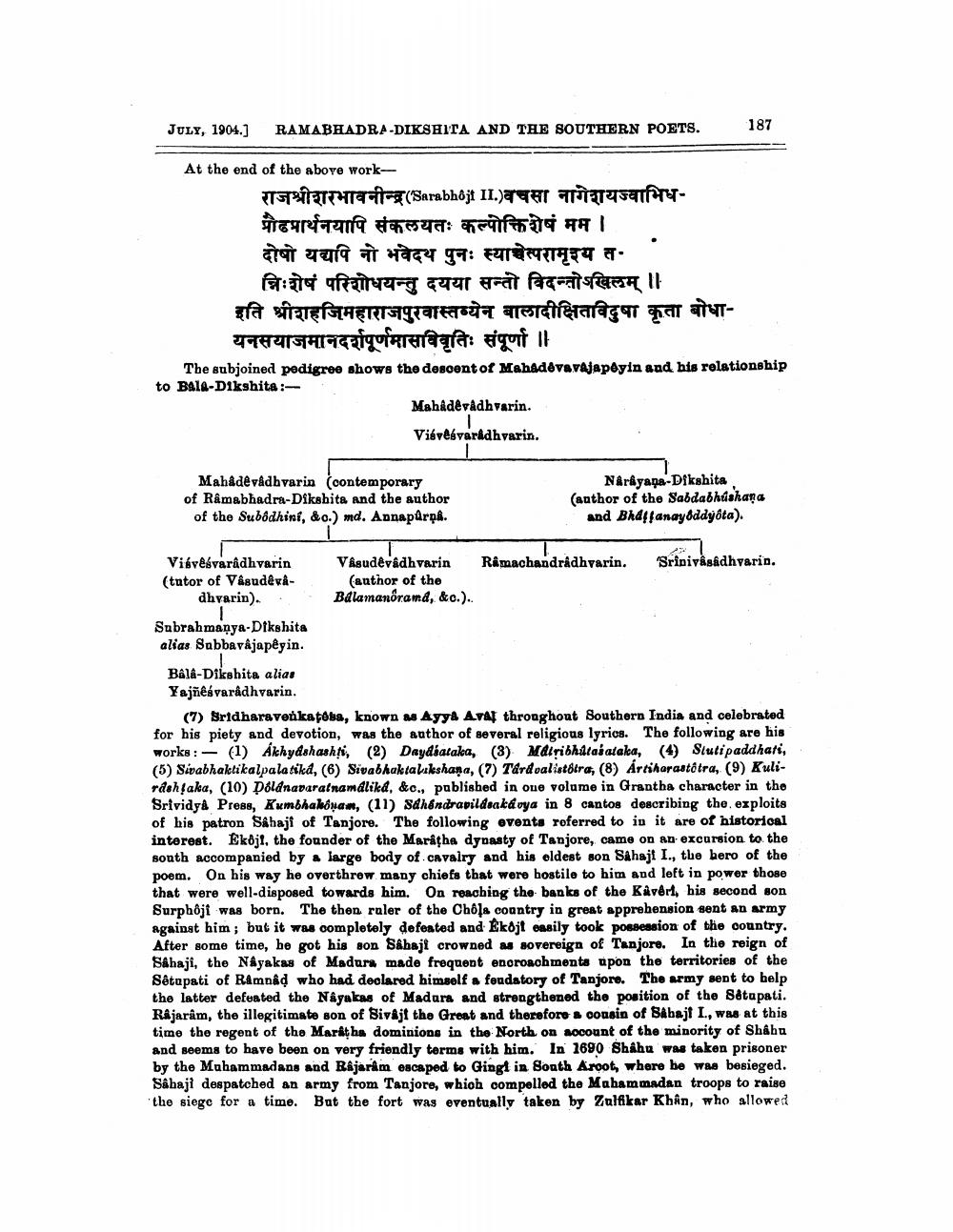________________
JULY, 1904.)
RAMABHADRA-DIKSHITA AND THE SOUTHERN POETS.
187
At the end of the above work
TSETT ('Sarabhojt II. TIETYSafप्रौढपार्थनयापि संकलयतः कल्पोक्तिशेषं मम । दोषो यद्यपि नो भवेदय पुनः स्यात्परामृश्य त.
निःशेष परिशोधयन्तु दयया सन्तो विदन्तोखिलम् ॥ इति श्रीशहजिमहाराजपुरवास्तम्येन बालादीक्षितविदुषा कृता बोधा
यनसयाजमानदर्शपूर्णमासविवृतिः संपूर्णा ॥ The subjoined pedigree shows the descent of Mahadevavajapeyin and his relationship to BA1A-Dikshita :
Mahadevádhvarin. Visvesvaradhvarin.
Mahadevadbyarin (contemporary of Råmabhadra-Dikshita and the author of the Subodhiri, &c.) md. Annaparpa.
Nárayana-Dikshita (author of the Sabdabhúshana
and Bhdjlanayoddyôta).
Visvēsvaradhvarin Vasudevadhvarin Ramachandrådhvarin. Srinivâsadhvarin. (tutor of Vasudeva- (author of the
dhvarin). . Balamanoramd, &c.). Subrahmanya-Dikshita alias Sabbavâjapêgin. BAIA-Dikshita alias Yajñêsvarådhvarin.
(7) Sridharavenkatóba, known as Ayyd Aval throughout Southern India and celebrated for his piety and devotion, was the author of several religious lyrics. The following are his works : - (1) Akhydshash, (2) Deydáataka, (3) Mairibhitarataka, (4) Stuti paddhati, (5) Swabhaktikalpalatska, (6) Sivabhaktalikshana, (7) Tárd valistdira, (8) Artiharastotra, (9) Kulirdehļaka, (10) Doldnavaratnamdlikd, &c., published in one volume in Grantha character in the Srividya Press, Kumbhakowan, (11) sdhendrapildsaká vya in 8 cantos describing the exploits of his patron Sáhaji of Tanjore. The following events roferred to in it are of historical interest. Eköjt, the founder of the Maratha dynasty of Tanjore, came on an excursion to the south accompanied by a large body of cavalry and his eldest son Sahaji I., the bero of the poem. On his way he overthrow many chiefs that were hostile to him and left in power those that were well-disposed towards him. On reaching the banks of the Kåvert, his second son Surphôji was born. The then ruler of the Choļs country in great apprehension sent an army against him; but it was completely defeated and Ekøjt easily took possession of the country, After some time, he got his son Sahaji crowned as sovereign of Tanjore. In the reign of Sáhaji, the Nayakas of Madurs made frequent encroachments upon the territories of the Setupati of Rannad who had declared himself a feudatory of Tanjore. The army sent to help the latter defeated the Näyukas of Madars and strengthened the position of the Setupati. Rajaram, the illegitimate son of Sivajt the Great and therefore a cousin of Babaji L., was at this time the regent of the Marktha dominions in the North on account of the minority of Shehu and seems to have been on very friendly terms with him. In 1690 Shahu was taken prisoner by the Muhammadans and Rajaram escaped to Gingt in South Aroot, where he was besieged. Sáhaji despatched an army from Tanjore, which compelled the Mahammadan troops to raise the siege for a time. But the fort was eventually taken by Zulfikar Khan, who allowed




